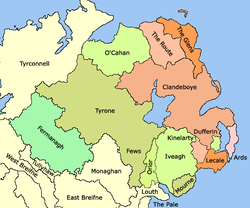Fermanagh
Fermanagh Fir Manach (Irish) | |||||||||||
|---|---|---|---|---|---|---|---|---|---|---|---|
| 10th century–1607 | |||||||||||
 Fermanagh in the 15th–16th centuries | |||||||||||
| Capital | Lisnaskea[1] | ||||||||||
| Common languages | Irish | ||||||||||
| Government | Elective monarchy | ||||||||||
| King / Chief | |||||||||||
• d.1009 | Cathal Ó Dubhdara | ||||||||||
• 1600–1607 | Cú Chonnacht Óg Mag Uidhir (last; half-brother of Hugh Maguire)[2] | ||||||||||
| History | |||||||||||
• Established | 10th century | ||||||||||
• Disestablished | 1607 | ||||||||||
| |||||||||||
| Today part of | United Kingdom of Great Britain and Northern Ireland | ||||||||||
Historically, Fermanagh (
History
This section needs additional citations for verification. (May 2017) |
Laighin ancient origins
The original Fir Manach or Fear Manach, that is to say the Manach or Monaigh people in the north of Ireland, claimed descent from the
Connachta and Three Collas
The geopolitical situation in Ireland changed during the 4th and 5th centuries, owing to the rise of the descendants of
11th century onwards
By the end of the 11th century, Fermanagh had decisively re-emerged as a sovereign kingdom in the region. The rulers of this kingdom were drawn from the Airgíalla. Early on the territory drew kings from three branches of Clann Lugainn; the Ó hEignigh (O'Heany), Maolruanaidh (Mulrooney) and Ó Dubhdara (Darragh). These families claimed descent from the Three Collas, in the person of Colla Fochríth and were thus kinsmen of the MacMahon
Kings of Fermanagh
The Annals of the Four Masters mention the following as Kings of Fermanagh (Irish: Fir Manach).[7]
- Cathal Ó Dubhdara (died 1009)
- Niall Ó hÉicnigh (died 1053)
- Domhnall Ó Mael Ruanaidh (died 1057)
- Giolla Críst Ó Dubhdara (died 1076)
- Ó hÉicnigh (died 1095)
- Laidhgnén Ó Dubhdara (died 1118)
- Ó Mael Ruanaidh (1126)
- Gilla Críost Ó hÉicnigh (died 1127), also over-king of Airgíalla.
- Faelán Ó Dubhdara (died 1128)
- Ó Mael Ruanaidh (died 1160)
- Mac an Oíche Ó Mael Ruanaidh (1189)
- Aonghus Mac Giolla Fhinnéin (died 1234)
- Domhnall Mór Ó Domnhaill (died 1241), also king of Tyrconnell (Tír Chonaill).
- Flaithbertach Ó Daimin (died 1275)
- Donn Mág Uidhir (died 1298)
- Mac Craith Mág Uidhir (died 1306)
- Flaithbertach Mág Uidhir (died 1324)
- Aodh Ó Domhnaill (died 1333), also king of Tyrconnell.
- Ruaidhri Mág Uidhir (died 1338)
- Aodh Ruadh Mág Uidhir (1360)
- Pilib Mág Uidhir (died 1366)
- Brian Mág Uidhir (died 1373)
- Pilib 'na Tuagh' Mág Uidhir (died 1394)[8]
- Tomás Mág Uidhir (died 1419)[contradictory]
- Tomás Mór Mag Uidhir - the son of Pilib na Tuagh Mág Uidhir - (died 1430)[8]
- Tomás Óg Mág Uidhir (abdicated 1471; died 1480)[9]
- Éamonn Mág Uidhir (or, 'Éamonn mac Tomás Óg Mág Uidhir') deposed 1488 (died 1488, later that year)[9]
- Tomás Óg mac Tomás Óg Mág Uidhir (died 1501)[9]
- Seaán Mág Uidhir (died 1503)
- Conchobhar Mór Mág Uidhir (died 1527)
- Cú Chonnacht Óg ‘an Comharba’ Mág Uidhir (died 1537)[2]
- Giolla Pádraig Bán Mág Uidhir (died 1540)
- Seán Mág Uidhir (died 1566)
- Cú Chonnacht Óg Mág Uidhir (died 1589)[2]
- Aodh Mág Uidhir (or, 'Hugh Maguire') (died 1601)
- Cú Chonnacht Óg Mág Uidhir (fled 1607 in the Flight of the Earls; died 1608)[2]
References
- ISBN 9781843830900.
- ^ .
In 1607 Cú Chonnacht Óg left Ireland ... His ship put in at Genoa, where he died of fever on 12 August 1608
- ^ a b MacCotter, Paul. Medieval Ireland: territorial, political and economic divisions. Four Courts Press, 2008, p.243
- ^ FitzPatrick, Elizabeth. Royal Inauguration in Gaelic Ireland. Boydell Press, 2004. p.84
- ^ a b "Fir Managh". Ireland's History in Maps. 26 January 2017.
- ^ Livingstone 1969, p. 6.
- ^ "Origin of Darragh/Dorrough". Electric Scotland. 26 January 2017.
- ^ . Retrieved 26 July 2021.
- ^ . Retrieved 26 July 2021.
Bibliography
- Livingstone, Peadar (1969). The Fermanagh Story: A Documented History of the County Fermanagh from the Earliest Times to the Present Day. Cumann Seanchais Chlochair.
External links
- Irish Chiefs and Clans in Fermanagh at Library Ireland
- Baronies of Ireland at Ireland's History in Maps

